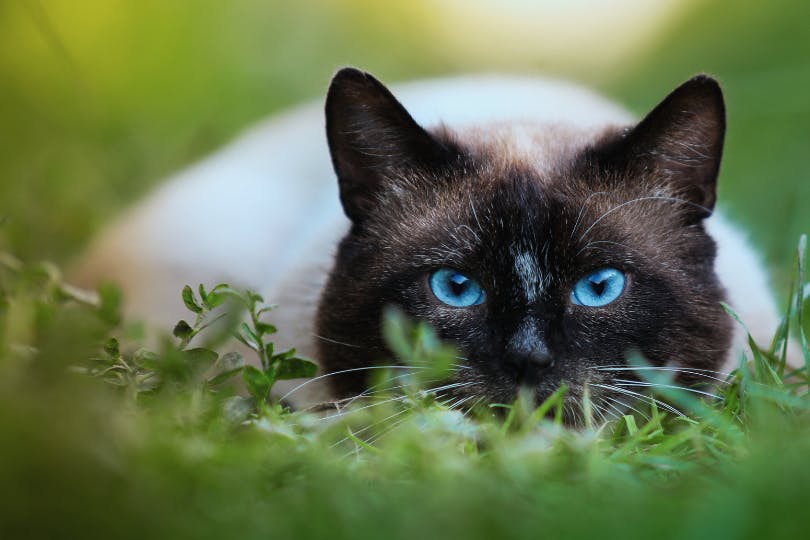- Home
- The Daily Wag!
- Senses
- How Do Cats See?

Cats love to watch the world around them. If you’re a cat parent, you’ve undoubtedly found your feline companion hanging out by the window on several different occasions. But what does Fluffy see when they gaze out the window, watch TV, or look up at you asking for food?
To human eyes, the world is full of vibrant colors and vivid details, but feline vision works differently. It turns out that they don’t see the same hues that we can, and they can’t see as far, either. So, what is the explanation for this, and what does the world look like through a cat’s eyes? Read on to find out!
Just like your eyes, a cat’s eyes function by letting light in, focusing on objects, and producing images that are transmitted to the brain. Feline eyes also have many of the same parts as human eyes, including the sclera, cornea, iris, pupil, and retina. The retina contains light-sensitive cells called photoreceptors, and this is where the biggest difference between human vision and cat vision lies.
The two main types of photoreceptors are rods and cones. Rod cells are responsible for peripheral vision and seeing in low light, while cone cells are responsible for color vision and seeing in bright light. Human eyes have a large number of cones and a small number of rods, which is why we’re good at detecting color and detail but can’t see well in the dark.
On the other paw, cat eyes have a large number of rods and a small number of cones. So while our feline friends can’t see rich color or fine detail, they’re able to move around in the dark without any problems. In fact, they can see six times better in dim light than us, hence the myth that cats have night vision.
Speaking of myths, there’s a common misconception that cats only perceive the world in shades of gray. While it’s true that cats do not experience the same color spectrum as humans, they can see some muted colors, similar to a person who is color blind. Cats can see shades of blue and green, but not pinks and reds.
Cats may see something we don’t, though. Researchers behind a study published in 2014 found that several animals, including cats, have lenses that allow some UV light to pass through, suggesting that our feline companions can see in ultraviolet!
Cats are nearsighted, according to experts. Unlike human eyes, cat eyes don’t have muscles that enable the lens to change its shape to focus on objects at various distances, so they can’t see objects that are far away. In addition, cats have a visual acuity (the sharpness or clarity of vision) of 20/100 to 20/200. Compared with the average human visual acuity of 20/20, this means that a cat has to be at 20 feet to see what a person can see at 100 or 200 feet.
While this may not sound too impressive from a human’s perspective, kitty vision is very useful in hunting and catching prey. A cat’s nearsightedness and visual acuity allow them to detect small movements and hidden shapes, as well as judge speed and distance accurately. Cats also have a visual field (the area that can be seen straight ahead, above, below, and to the side when the eyes focus on a single point) that’s 20 degrees wider than that of humans.
Ever wondered what your cat sees when they look at you? Since cat vision and human vision are different, your feline friend doesn’t see you the same way you see yourself. And since Whiskers is nearsighted, you probably look like a big blur to them if you’re standing too far away.
A 2005 study also found that while cats can recognize other feline faces, they’re not very good at recognizing human faces. When shown pictures of a familiar cat and an unfamiliar cat, cats chose the former about 90 percent of the time. But when shown pictures of their handler’s face and a stranger’s face, they chose the former only about half the time.
However, cats rely on more than just vision to identify people; they use hearing, smell, and touch as well. In a 2013 study, researchers played recordings of cats’ names being called by their humans and strangers. The participating felines showed the strongest reactions when they heard a familiar voice, indicating their ability to distinguish human voices.
Due to a large number of rod cells and a small number of cone cells in feline eyes, cats can’t detect bright color and fine detail but can see very well in the dark. They may even be able to see in ultraviolet due to the anatomy of their eyes. Cats are also nearsighted, and their ability to see close objects is well-suited for spotting the small prey they hunt.
Have questions or concerns about your pet?
Chat with a veterinary professional in the Wag! app 24/7.
Get Vet ChatWritten by Aurus Sy
Veterinary reviewed by:
Published: 08/22/2024, edited: 08/22/2024
More articles by Aurus Sy
